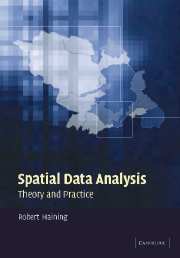Book contents
- Frontmatter
- Contents
- Preface
- Acknowledgements
- Introduction
- Part A The context for spatial data analysis
- Part B Spatial data: obtaining data and quality issues
- Part C The exploratory analysis of spatial data
- Part D Hypothesis testing and spatial autocorrelation
- 8 Hypothesis testing in the presence of spatial dependence
- Part E Modelling spatial data
- Appendix I Software
- Appendix II Cambridgeshire lung cancer data
- Appendix III Sheffield burglary data
- Appendix IV Children excluded from school: Sheffield
- References
- Index
8 - Hypothesis testing in the presence of spatial dependence
Published online by Cambridge University Press: 06 July 2010
- Frontmatter
- Contents
- Preface
- Acknowledgements
- Introduction
- Part A The context for spatial data analysis
- Part B Spatial data: obtaining data and quality issues
- Part C The exploratory analysis of spatial data
- Part D Hypothesis testing and spatial autocorrelation
- 8 Hypothesis testing in the presence of spatial dependence
- Part E Modelling spatial data
- Appendix I Software
- Appendix II Cambridgeshire lung cancer data
- Appendix III Sheffield burglary data
- Appendix IV Children excluded from school: Sheffield
- References
- Index
Summary
This chapter examines a number of commonly used statistics and describes how methods of statistical inference are affected when the data are assumed to derive from a generating model (see section 2.1.4) which does not satisfy the conventional assumption of independence. Spatial data often fail to satisfy the conventional model underlying statistical inference. So in using certain tests, such as the usual tests for differences of means or correlation found in conventional statistical texts, the analyst should be concerned about the possible effect of spatial dependence on test results.
When n observations are made on a variable that is spatially dependent (and that dependence is positive so that nearby values tend to be similar) the amount of information carried by the sample is less than the amount of information that would be carried if the n observations were independent. When observations close together in geographic space are dependent in this way, taking a second measurement close to another may not provide much additional information about the process. A general consequence of this is that the sampling variance of statistics are underestimated. As the level of spatial dependence increases the underestimation increases. (This effect is reversed if spatial dependence is negative – the sampling variance of the statistic is overestimated.)
Where there is positive spatial dependence and the analyst wants to place confidence intervals on statistics then these intervals will be misleadingly small giving a spurious impression of the level of precision of the estimated quantity.
- Type
- Chapter
- Information
- Spatial Data AnalysisTheory and Practice, pp. 273 - 286Publisher: Cambridge University PressPrint publication year: 2003
- 2
- Cited by



